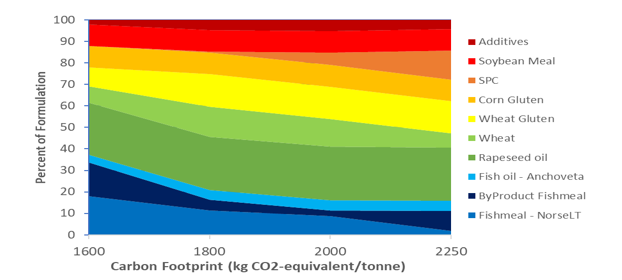This piece written by Dr Brett Glencross was published in the October 2023 edition of International Aquafeed:
Recently I was experimenting with various salmon feed formulations and ended up investigating the impacts that introducing constraints to the carbon footprint might bring in terms of ingredient sourcing options. To do this I simply used the same approach we would traditionally use to achieve least-cost linear formulating on diet composition optimisation, but in this case, it was simply extended to include data from the Global Feed LCA Institutes (GFLI) database [www.gfli.org].
The exercise showed several things. Firstly, that it was relatively straightforward exercise to include carbon footprint as a formulation parameter. The wide range of data in the GFLI database allowed various ingredient options to be considered, but I chose to stick to the regional European resourcing (RER) category for simplicity’s sake and comparative exercise. I then formulated a standard grower diet for a 1000g Atlantic salmon (something akin to 36% digestible protein, 30% lipid, 20.0 MJ of digestible energy and balanced for all the usual micronutrients). A standard salmon diet like this had a carbon footprint around 2250 kg CO2-equilaent per tonne of feed. I then progressively introduced constraints to the carbon footprint until I reached a carbon footprint around 1600 kg CO2-equivalent per tonne of feed. Now, assuming current ingredient prices (or there abouts), this exercise showed that a 29% decrease in carbon footprint of the feed only increased the formulation cost by about 3.2%.
What was just as interesting as the cost observation, was the change in ingredient profile as the carbon footprint was decreased. Here we saw the clear reduction in certain agricultural commodities and an increase in the use of marine ingredients. Notably the use of fishmeal increased from about 11% to over 33% in the formulation as the carbon footprint was increasingly constrained. Not only was there a three-times increase in fishmeal use, but there was also a clear trend towards increasing the utilisation of by-product fishmeals because of the low footprint they possess. Now with each of the major European salmon feed companies making public statements about how they intend to decrease the carbon footprint of their feeds by a third or more by 2030, it makes you think about what ingredients will be preferentially sourced to chase that target.

Figure 1. Change in formulation ingredient profile with increasing constraints on carbon footprint. All carbon footprint data was based on GFLI ReCiPe Economic allocation to products based on RER (European Sourcing).








